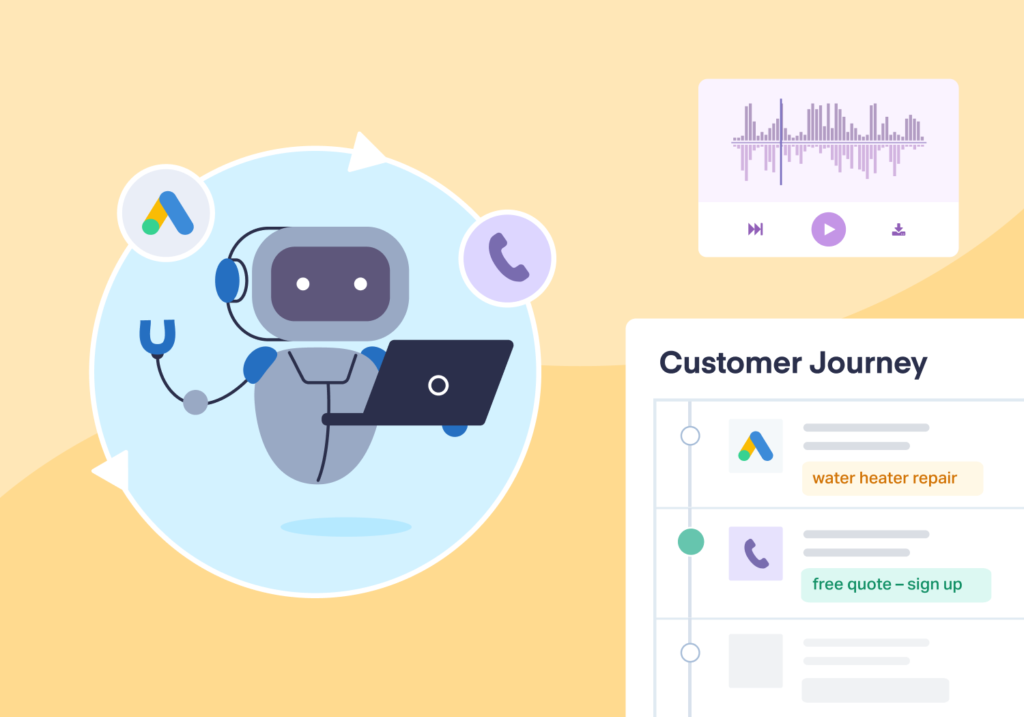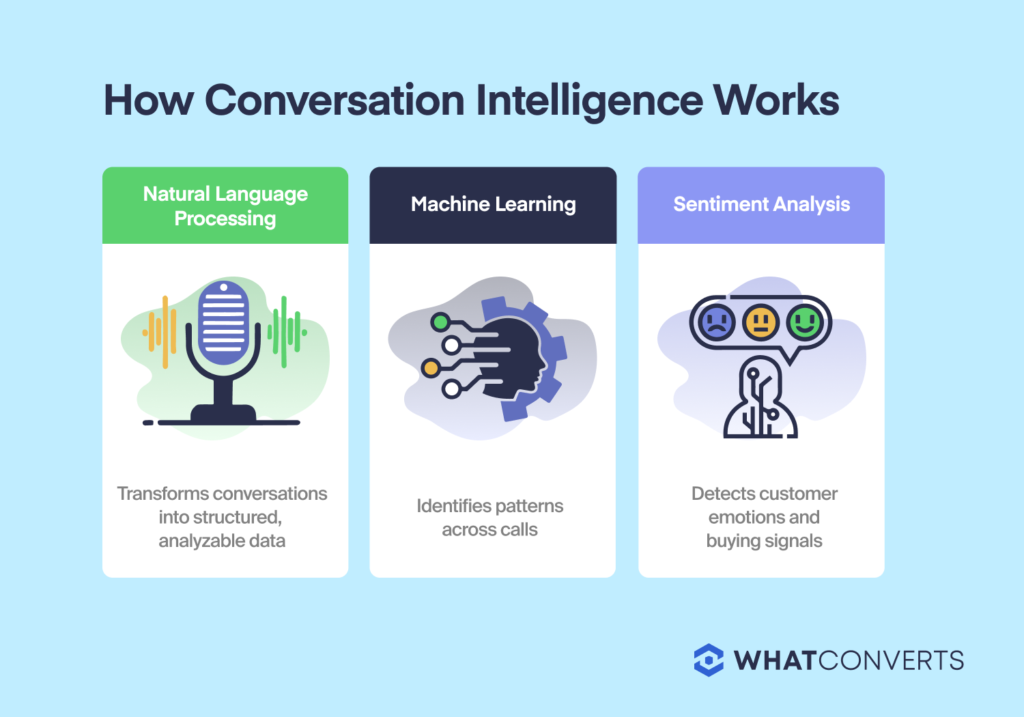
Your sales team just wrapped another call with a promising lead. The conversation seemed positive, but now comes the hard part—actually turning that interest into revenue. If you're like most businesses, your team probably spends hours manually reviewing call recordings, taking notes, and trying to piece together what worked and what didn't.
But what if AI could do all that heavy lifting for you? What if you could automatically extract actionable insights from every single customer conversation? That's exactly what conversation intelligence makes possible.
What is Conversation Intelligence and Why Does it Matter?
Conversation intelligence uses artificial intelligence and machine learning to analyze sales calls, generating insights about customer sentiment, pain points, and buying signals. But it goes beyond simple transcription—modern conversation intelligence platforms can identify patterns across hundreds or thousands of calls to help you understand what messaging resonates with customers and what approaches lead to conversions.
This matters because phone calls remain one of the highest-intent touchpoints in the sales process. When someone picks up the phone to call your business, they're typically much closer to making a purchase decision than someone just browsing your website. The intelligence gathered from these crucial conversations can inform everything from sales training to marketing strategy.
Here are some of the key capabilities that make conversation intelligence so valuable:
- Automatic transcription and analysis of every call
- Identification of key topics, questions, and objections
- Sentiment analysis to gauge customer reactions
- Pattern recognition across large volumes of calls
- Integration with CRM and sales tools
How Conversation Intelligence Actually Works
Understanding the mechanics of conversation intelligence helps you implement it more effectively. At its core, the technology combines three key components:
- Natural Language Processing (NLP) analyzes the actual content of conversations, breaking down speech into data that can be processed and analyzed. This enables the system to identify specific topics, keywords, and patterns in how both customers and sales reps communicate.
- Machine Learning algorithms then process this data to identify patterns and correlations. They can recognize which conversation elements tend to lead to successful outcomes versus unsuccessful ones. The system gets smarter over time as it analyzes more calls.
- Sentiment Analysis examines factors like tone, pace, and word choice to gauge the emotional state of both parties. This helps identify points of enthusiasm or concern during calls that might not be obvious from the transcript alone.
These three components work together in a synchronized process that transforms ordinary sales calls into strategic assets. When a customer call occurs, the conversation is first transcribed and processed through NLP. The resulting structured data is then analyzed by machine learning algorithms that compare it against historical patterns. Finally, sentiment analysis adds an emotional layer to the data, helping sales teams understand not just what was said, but how it was received. With platforms like WhatConverts, this entire process happens automatically, providing real-time insights that would be impossible to generate manually.
What Is Lead Intelligence?
Conversation intelligence is employed by many different companies and platforms, and Lead Intelligence is WhatConverts’s conversation AI feature. It can be thought of as “conversation intelligence plus”—in addition to analyzing the content of your conversations and helping you see patterns and insights, it can also automatically qualify, value, and action leads based on that information.
For example, let’s say that you’re a roofing contractor. After a few months of collecting conversation intelligence data, you’ve identified that 75% of callers that mention “leak repair” eventually convert to customers. You can set up Lead Intelligence so that, when it analyzes your call transcripts, it will automatically mark any callers that mention “leak repair” as qualified leads in your database.
What’s more, Lead Intelligence can also assign values to your leads—so if you know that the average revenue from a leak repair is $1,500, you can set the platform up to both set these callers as qualified and assign them a quote value of $1,500.
Key Benefits of Implementing Conversation Intelligence
Improved Sales Performance
Conversation intelligence transforms how sales teams operate by providing new visibility into what actually happens during customer interactions. Sales managers can identify specific moments in calls where reps excelled or struggled, and can point to exact instances where different approaches could have been more effective, creating teachable moments backed by real evidence.
The technology also lets teams identify successful patterns across the entire sales organization. When certain phrases, response techniques, or conversation flows consistently lead to conversions, these best practices can be documented and shared across the team.
Better Lead Qualification
One of the most valuable applications of conversation intelligence is improving how you qualify phone leads. The technology can automatically identify signals that indicate whether a prospect is likely to convert, helping you focus resources on the most promising opportunities.
This qualification happens on multiple levels:
- Immediate intent signals during the call (specific phrases or questions that indicate buying readiness)
- Historical patterns based on analysis of past successful conversions
- Integration with other data sources to build a complete picture of lead quality
This multi-dimensional approach to lead qualification fundamentally changes how sales teams prioritize their efforts. By identifying high-potential prospects early in the sales process, teams can allocate their most valuable resource—time—to opportunities with the greatest likelihood of closing. This not only improves conversion rates but also shortens sales cycles by preventing reps from investing excessive energy in leads that aren't ready to buy.
Enhanced Customer Intelligence
Beyond individual call analysis, conversation intelligence provides valuable aggregate data about your customer base. The system can identify:
- Common pain points that drive people to seek your solution
- Frequent objections or concerns that need to be addressed
- Competitive intelligence based on mentions of alternatives
- Industry-specific terminology and use cases
These aggregate insights become a strategic asset that extends far beyond the sales department. Product teams can use this intelligence to prioritize features that address common pain points mentioned in sales conversations. Marketing teams gain clarity on messaging that resonates with prospects and objections that need addressing in campaigns. Executive leadership gets a ground-level view of market sentiment and competitive positioning based on actual customer conversations, not just surveys or third-party research. In this way, conversation intelligence creates a unified source of customer truth that aligns the entire organization.
Conversation Intelligence vs. Conversational Intelligence
When talking about Conversation Intelligence, you may also come across a similar term: Conversational Intelligence. While it’s just two letters that differentiate these terms, their meanings are actually very different.
Conversation Intelligence analyzes conversations after they occur, identifying patterns, extracting insights, and helping businesses understand what's happening in their customer communications. This technology isn't participating in the conversation—it's studying conversations to help teams improve future interactions.
Conversational Intelligence, on the other hand, powers real-time dialogue. It's the technology behind chatbots and virtual assistants that actively engages with users. This AI is a direct participant in the conversation, generating responses and adapting to user inputs as the interaction unfolds. It focuses on a single conversation at a time, striving to create a natural, helpful exchange.
The distinction matters because they solve different business problems. Conversation intelligence helps teams understand performance trends and customer needs across many interactions, while conversational intelligence automates individual customer interactions. Many businesses benefit from both—using conversational intelligence to handle routine inquiries efficiently while applying conversation intelligence to analyze those interactions and continue improving their communication strategy.
Best Practices for Implementation
Focus on Data Quality
The value of your conversation intelligence system is directly proportional to the quality of data it analyzes. Even the most sophisticated AI can't extract meaningful insights from poor-quality inputs. Start by ensuring you're capturing good quality audio recordings with minimal background noise. Properly configure integration points with your CRM and other sales tools to maintain data consistency across systems.
Develop clear protocols for handling sensitive customer information, including when to redact certain content from transcripts. Establish a regular cadence for auditing transcription accuracy—this not only improves the quality of your data but also builds trust in the system among your team.
Train Your Team Effectively
Technology adoption often fails not because of the solution itself, but because of how it's introduced to the team. Conversation intelligence can initially seem intimidating to sales representatives who may worry it's meant to monitor or criticize their performance. Proper training helps them see it as a valuable tool that makes their jobs easier rather than a burden or threat.
Develop a comprehensive training program that covers both technical and strategic elements. Include privacy and compliance considerations so team members understand appropriate usage boundaries. Consider identifying "power users" who can serve as internal champions and informal technical support for their colleagues. Most importantly, emphasize how the technology saves time and improves results rather than adding workload—showing concrete examples of these benefits during training significantly increases adoption rates.
Getting Started with Conversation Intelligence
Conversation intelligence has fundamentally changed how businesses understand and optimize their customer interactions. By transforming unstructured conversations into actionable insights, these tools help companies identify what's working, address what isn't, and continually refine their approach to sales and customer engagement.
Whether you're looking to improve sales performance, enhance lead qualification, gather better customer intelligence, or all of the above, conversation intelligence provides the insights you need to make informed decisions and convert more leads into loyal customers. In today's competitive business environment, that level of intelligence isn't just advantageous – it's essential.
Ready to see how conversation intelligence can transform your lead conversion process? Start your free 14-day trial of WhatConverts today and discover how our Lead Intelligence technology takes conversation analysis to the next level, automatically qualifying and valuing your leads based on comprehensive data from throughout the customer journey.
Get a FREE presentation of WhatConverts
One of our marketing experts will give you a full presentation of how WhatConverts can help you grow your business.
Schedule a Demo
Grow your business with WhatConverts







